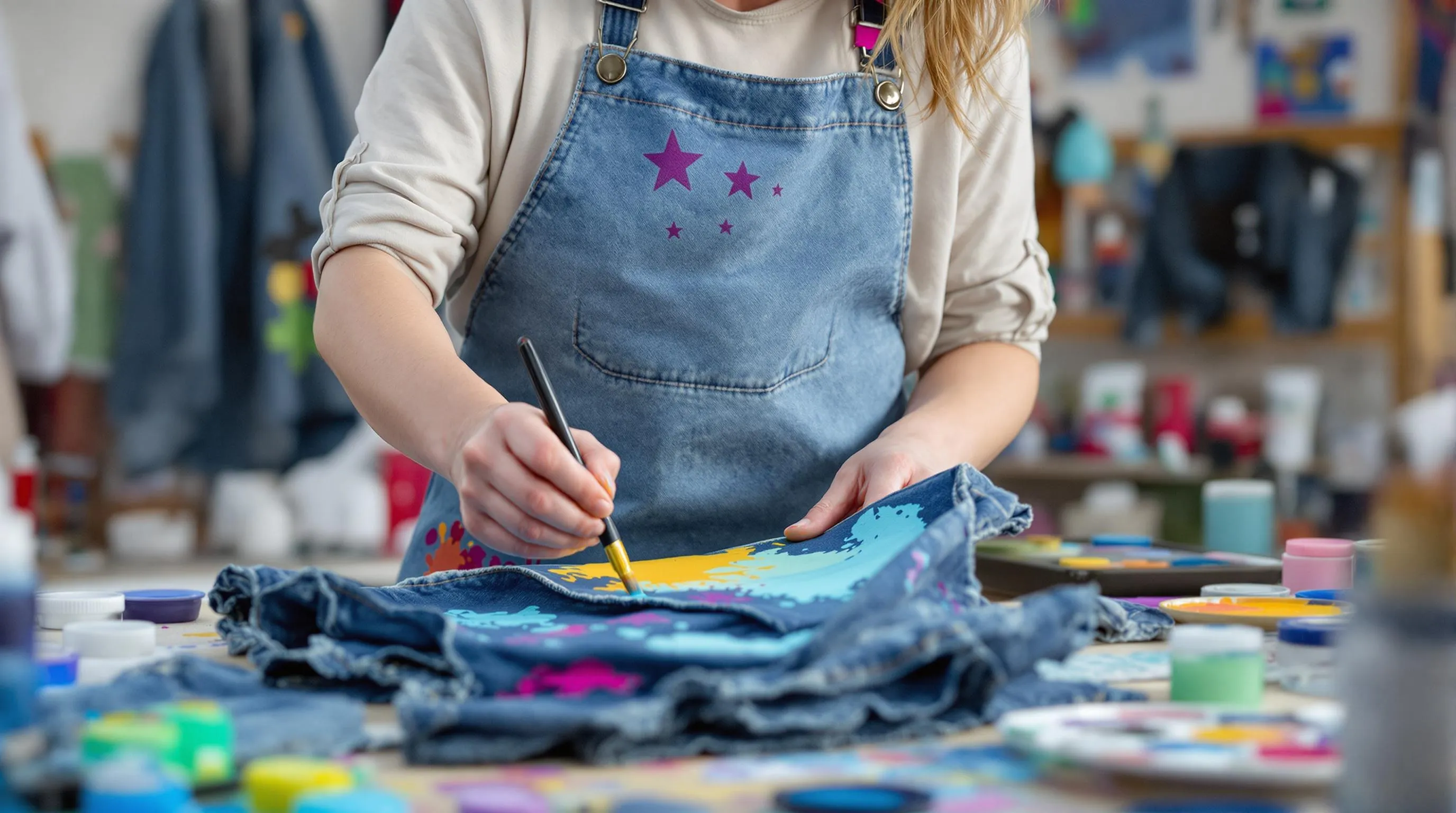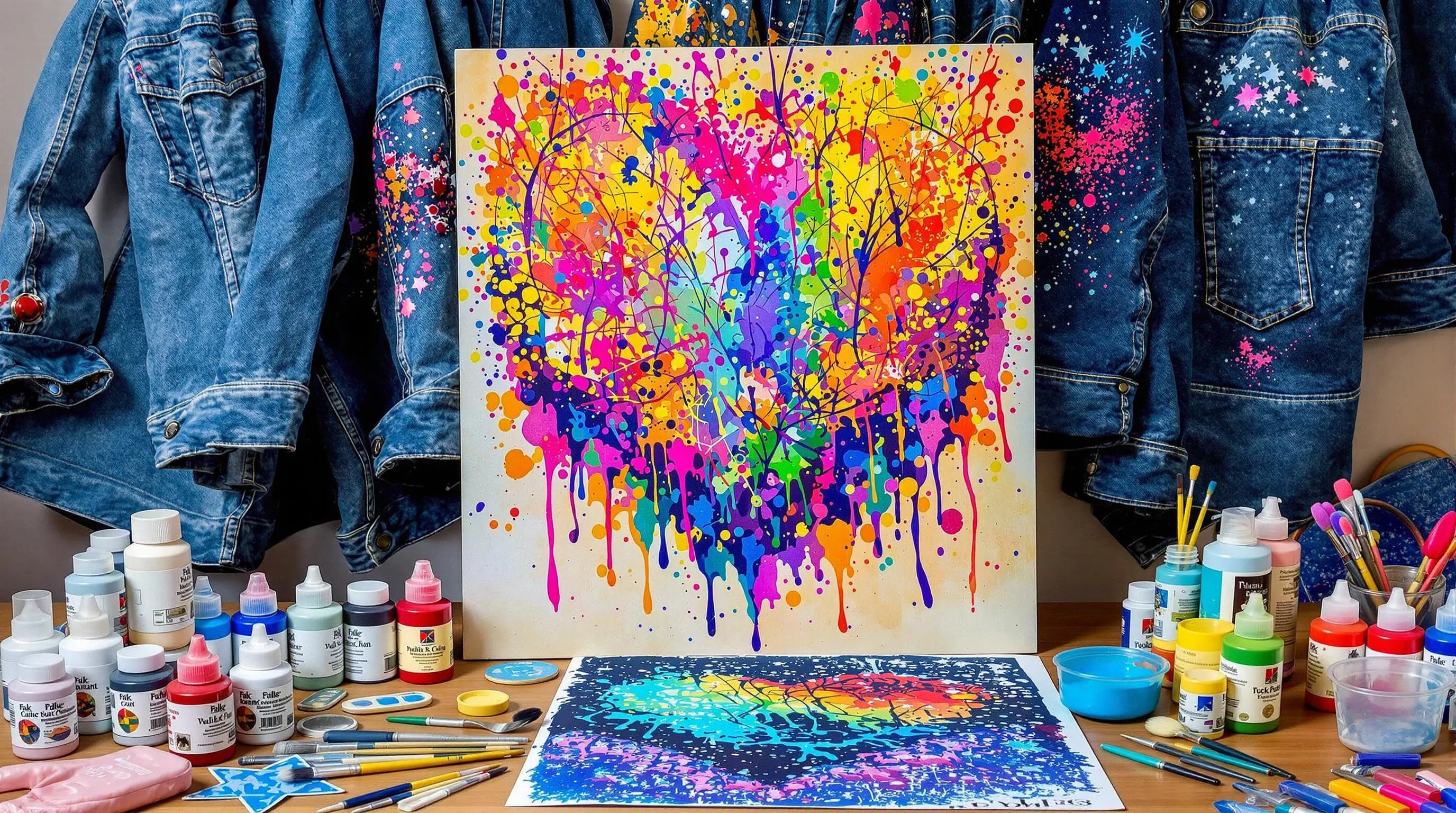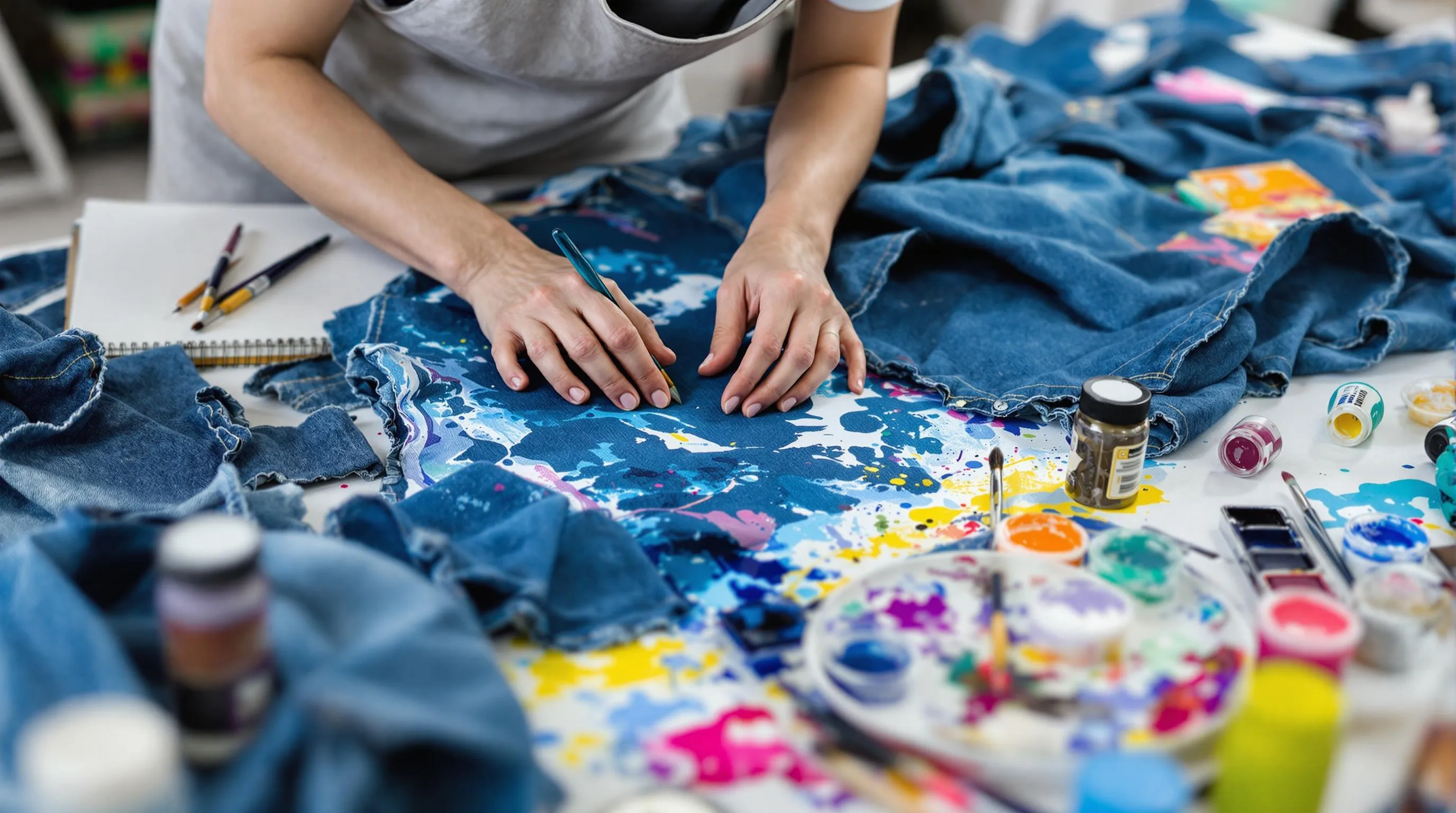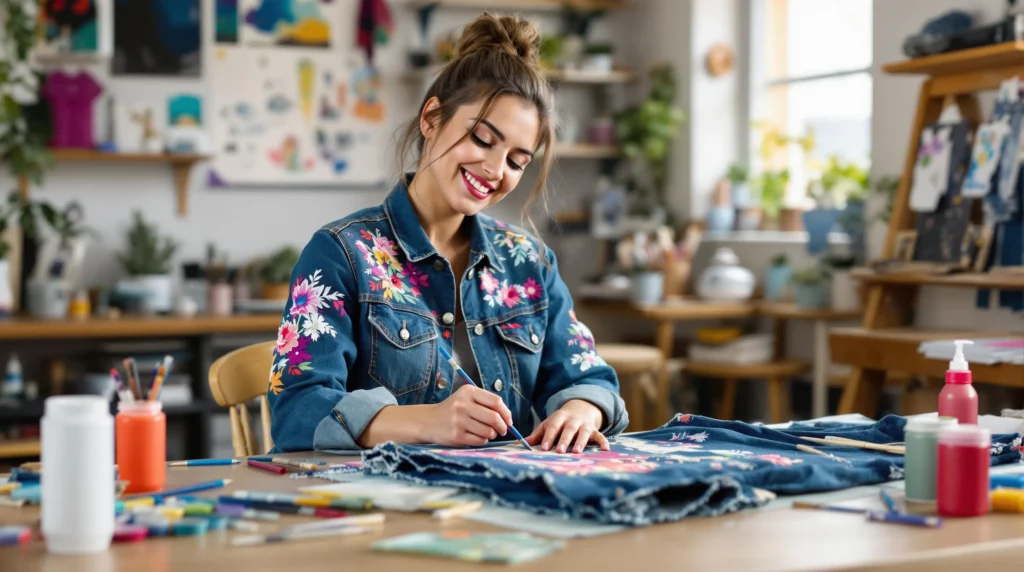Looking to add some personality to your denim? We’ve got you covered! Painting denim fabric is a fantastic way to transform plain jeans, jackets, or bags into custom pieces that showcase your creativity. But not all paints are created equal when it comes to working with this sturdy cotton material.
We’ve tested dozens of fabric paints specifically on denim to find options that won’t crack, fade, or wash away after a few wears. From specialized textile paints to acrylic alternatives, our comprehensive guide will help you choose the perfect paint for your denim projects. Whether you’re a seasoned artist or trying fabric painting for the first time, the right paint makes all the difference in creating long-lasting, vibrant designs on your favorite denim items.
Why Paint Your Denim: Creative Possibilities and Benefits
Painting denim offers endless creative possibilities that transform ordinary garments into personalized wearable art. We’ve found that customized denim pieces allow you to express your unique style while standing out from mass-produced fashion. Many artists use painted denim as a canvas for self-expression, creating everything from subtle accents to bold statement pieces.
Upcycling old denim through painting breathes new life into items you might otherwise discard. Your favorite jeans with tears or stains can become trendy again with strategic paint application that covers imperfections while adding artistic flair. Fashion-forward individuals often choose to paint denim because it creates one-of-a-kind pieces that reflect personal aesthetics no store-bought item can match.
Painted denim also makes for thoughtful, personalized gifts that recipients treasure. Children particularly enjoy wearing custom-painted denim jackets or jeans featuring their favorite characters or designs. Businesses frequently use painted denim merchandise for brand promotion, creating distinctive items that customers actually want to wear.
From an economic perspective, painting denim lets you create designer-looking pieces without the designer price tag. Artists can establish profitable side hustles by selling custom-painted denim items online or at create fairs. Professional clothing designers often incorporate hand-painted denim into their collections to create premium, limited-edition pieces that command higher prices.
The therapeutic benefits of painting denim shouldn’t be overlooked either. Creating art on fabric provides stress relief and a meditative creative outlet that produces wearable results. Denim painting workshops have become popular social activities where friends gather to create while enjoying each other’s company.
Choosing the Right Paint for Denim Projects

When it comes to transforming your denim pieces into wearable art, selecting the right paint is crucial for creating designs that last. Let’s explore the key differences between paint types and how to choose the best option for your exact project.
Fabric-Exact vs. Multi-Surface Paints
Fabric-exact paints like Setacolor Opaque and Angelus Acrylic Paints (mixed with 2-Soft Fabric Medium) are specially formulated to maintain flexibility and adhere properly to denim fibers. These specialized options offer superior color vibrancy and impressive durability even after multiple wash cycles.
Multi-surface acrylics such as Amsterdam or Golden Heavy Body require the addition of textile medium to become denim-friendly. Without this crucial additive, standard acrylics will harden on your fabric, creating stiff patches that crack and peel with wear. Brands like Liquitex or Plaid FX Flexible can serve as effective undercoats to enhance opacity on darker denim materials.
For best results when working with lighter colors, we’ve found that applying a white acrylic base coat mixed with textile medium significantly improves color visibility on denim surfaces. Proper cleaning of your denim before painting is essential – using lint rollers helps ensure better paint adhesion and more professional-looking results.
Permanent vs. Temporary Options
Permanent paint answers include acrylics properly mixed with fabric medium, with Angelus being our top recommendation for longevity. These paints become machine-washable after proper heat-setting using an iron or heat gun. Setacolor Opaque and Golden Heavy Body acrylics also deliver exceptional color saturation that stands the test of time.
Temporary options consist of alcohol-based paints or undiluted acrylics applied without heat-setting, though these typically fade or crack quickly. Simply Spray products work adequately for lightweight fabrics but lack the durability needed for frequently worn denim items.
For professional-quality results, Golden Heavy Body acrylics offer superior performance, while Amsterdam products provide a more budget-friendly alternative without sacrificing much quality. We always recommend avoiding non-fabric paints used without medium, as they severely compromise the flexibility and longevity of your denim projects.
7 Best Fabric Paints for Denim Creations

After extensive testing across multiple denim projects, we’ve identified these seven standout paint options that deliver superior results for your creative endeavors.
Tulip Soft Fabric Paint for Flexible Designs
Tulip Soft Fabric Paint excels in flexibility and vibrant color retention, making it our top choice for denim projects that need to maintain their form through regular wear. The paint moves with your fabric rather than cracking or flaking, ensuring your designs stay intact even after multiple washes. Artists particularly appreciate this brand for its smooth application and ability to create crisp lines when used with stencils or freehand techniques.
Jacquard Textile Color for Professional Results
Jacquard Textile Color offers professional-grade quality with its high-pigment formulation that delivers exceptional durability on denim surfaces. The rich color saturation makes these paints ideal for detailed work where precision matters. We’ve found that Jacquard’s superior color fastness means your intricate designs will remain vibrant through countless washes, justifying its slightly higher price point for serious artists seeking professional results.
Arteza Fabric Paint Set for Vibrant Options
Arteza Fabric Paint Set provides an impressive range of vibrant colors including eye-catching metallic and neon options that pop against denim backgrounds. The semi-transparent quality allows for beautiful layering techniques while maintaining fabric softness, unlike stiffer paint formulations. Our tests confirm these paints remain durable through repeated washing cycles, making them perfect for creating statement pieces that require bold, long-lasting color varieties.
Angelus Acrylic Leather Paint for Durability
Angelus Acrylic Leather Paint, though primarily marketed for leather applications, performs remarkably well on denim thanks to its outstanding resistance to wear and environmental factors. The exceptional durability makes this paint perfect for high-friction areas like jean pockets or backpack straps that experience consistent rubbing. Artists creating denim pieces meant for heavy use will appreciate how these paints maintain their appearance without cracking or peeling under stress.
DecoArt SoSoft Fabric Acrylics for Beginner-Friendly Projects
DecoArt SoSoft Fabric Acrylics offer an accessible entry point for novice denim painters with their user-friendly formulation and consistent results. The paint spreads smoothly with minimal learning curve, allowing beginners to achieve vibrant results without specialized techniques. The forgiving nature of these acrylics makes corrections easier during the painting process, reducing frustration for those just starting their denim customization journey.
Createx Airbrush Colors for Advanced Techniques
Createx Airbrush Colors deliver superior performance for artists ready to elevate their denim projects with advanced airbrushing techniques. The finely milled pigments flow smoothly through airbrush systems, enabling the creation of detailed gradients, shadows, and realistic imagery on denim surfaces. Professional artists choose these colors when precision matters, particularly for commercial denim customization requiring photorealistic elements or complex color transitions.
Dye-Na-Flow Liquid Color for Watercolor Effects
Dye-Na-Flow Liquid Color creates stunning watercolor-like effects that transform denim with ethereal, flowing designs impossible to achieve with thicker paints. The ultra-fluid consistency penetrates fabric fibers beautifully rather than sitting on the surface, resulting in soft, blended color transitions. Artists seeking an organic, less structured aesthetic gravitate toward these colors for creating dreamy, abstract patterns that maintain the natural drape and feel of the denim.
Essential Tools and Materials for Painting Denim

Successful denim painting requires more than just the right paint—you’ll need several essential tools and materials to achieve professional-looking results. We’ve compiled a comprehensive list of everything you need to get started on your denim painting journey.
Quality Brushes
Quality brushes make all the difference when painting on denim fabric. We recommend investing in various brush sizes to achieve different effects—fine detail brushes for intricate designs, wider flat brushes for filling larger areas, and angled brushes for clean edges. Synthetic brushes often work best with acrylic paints and are more affordable than natural bristle options.
Fabric Medium
Fabric medium is absolutely essential when working with regular acrylic paints on denim. This specialized additive transforms standard acrylic paint into flexible fabric paint, improving durability and wash resistance. Without fabric medium, your painted designs may crack or flake after washing. Simply mix the medium with your acrylic paint according to the manufacturer’s instructions before application.
Heat Setting Tools
Heat setting is crucial for making your denim paint designs permanent and washable. A heat gun provides precise control and is highly recommended for professional results. Alternatively, an iron set to the appropriate temperature for denim can work well for larger surfaces. Proper heat setting fixes the paint to the fabric fibers, significantly improving durability through multiple washes.
Surface Protection and Masking Materials
Masking tape is indispensable for creating clean lines and protecting areas you don’t want painted. We suggest using low-tack painter’s tape to avoid damaging the denim fibers when removed. For more complex designs, consider using stencils or creating your own templates from cardstock. Also, place cardboard or plastic inside garments to prevent paint from bleeding through to the other side.
Preparation Tools
A lint roller should always be your first tool before painting begins. This simple device effectively removes debris, loose fibers, and dust from the denim surface, creating the ideal canvas for paint application. For best results, thoroughly clean your denim item and allow it to dry completely before starting your project.
Optional Specialized Equipment
While not strictly necessary, specialized equipment can elevate your denim painting projects. Airbrushes create smooth gradients and professional-looking effects when used with appropriate fabric paints. Palettes help with color mixing and paint conservation. Heat press machines provide consistent temperature and pressure for optimal paint setting, especially useful for batch production.
By gathering these essential tools and materials before starting your denim painting project, you’ll set yourself up for success and achieve more professional, long-lasting results on your fabric creations.
Step-by-Step Guide to Preparing Denim for Painting

1. Plan and Sketch Your Design
Creating a successful denim painting project starts with proper planning. We recommend sketching your design on paper first to visualize how it will appear on your denim piece. Consider the fabric’s natural folds and seams when planning your artwork, as these can affect how the design looks when worn. Using a light-colored fabric marker to transfer your sketch onto the denim ensures accurate placement before you commit to paint.
2. Prepare the Denim Surface
Proper preparation creates the foundation for a successful painting project. Lay your denim item completely flat on a protected work surface, ensuring it’s free of wrinkles. Clean the fabric thoroughly to remove any dirt, oils, or chemicals that might interfere with paint adhesion. A lint roller works perfectly for removing loose fibers and dust particles from the surface. Apply masking tape to cover areas you want to protect from paint splatter or to create clean edges for your design.
3. Mix the Paint Properly
Achieving the right paint consistency dramatically impacts your results. Combine acrylic paint with fabric medium in a 2:1 ratio to create a flexible, washable mixture that won’t crack or peel after drying. For thinner, more translucent effects, add small amounts of water to your mixture. Amsterdam Acrylics and Golden Heavy Body Acrylics deliver excellent results when properly mixed with fabric medium, providing vibrant colors that maintain their intensity even after multiple washes.
4. Apply Paint in Layers
Building up color gradually produces more professional results than applying thick coats. Begin with light base colors and progressively add details and darker shades. Allow each layer to dry completely before applying the next to prevent smudging and color bleeding. Angelus Acrylic Paints work exceptionally well for detailed work on denim, offering superior coverage while maintaining the fabric’s flexibility when applied correctly.
5. Heat-Set Your Finished Design
Heat-setting transforms your painted design from temporary to permanent. After your paint has dried completely (at least 24 hours), place a clean cloth over the painted area and iron on medium heat for 3-5 minutes, or use a heat gun held 6 inches away from the fabric. This crucial step polymerizes the paint molecules, bonding them permanently to the denim fibers and significantly improving wash resistance. Testing the heat-setting on a small, inconspicuous area first ensures you don’t damage your artwork or the fabric.
Techniques for Applying Paint to Denim Fabric

Once you’ve prepared your denim and selected the right paint, mastering various application techniques will help you achieve professional-looking results. Different methods create unique effects, allowing for endless creative possibilities on your denim projects.
Brushing Methods for Different Effects
Brushing techniques form the foundation of denim painting, with each brush type offering distinct advantages. Fine brushes work exceptionally well for intricate details, allowing you to create precise lines and small decorative elements with control and accuracy. Flat brushes deliver broader, smoother coverage that’s perfect for filling in larger areas with consistent color. For textured effects, try stippling with a stiff-bristled brush to create dimension. Dry brushing—applying paint with minimal moisture on your brush—creates a weathered, vintage appearance that complements denim’s casual nature. We recommend starting with basic brushstrokes on scrap denim before tackling your main project to build confidence and refine your technique.
Stenciling and Masking Techniques
Stenciling offers a foolproof way to create clean, professional designs even for beginners. Secure your stencils firmly against the denim surface to prevent paint bleeding, using heat if necessary to ensure proper adhesion. Apply paint over the stencil using thin layers rather than one thick coat to minimize seepage under the edges. Masking tape works brilliantly for creating sharp geometric patterns and stripes on denim projects. Freezer paper stencils provide an excellent option for custom designs—simply iron the shiny side to the fabric for a temporary bond that peels away cleanly after painting. Remove stencils while the paint is still slightly wet to avoid peeling dried paint and damaging your design’s crisp edges.
Spraying and Airbrushing Applications
Spraying and airbrushing create effects that are difficult to achieve with traditional brushwork. Airbrushes excel at producing subtle gradients, ombré effects, and highly detailed designs with professional-looking results. Spray techniques generate interesting textured patterns, especially when spraying through stencils or masks for controlled application. Diluting your paint slightly improves flow through spray equipment, though always check manufacturer guidelines for proper viscosity. Distance matters significantly with spraying methods—holding the applicator farther from the fabric creates softer edges, while closer application produces more defined lines. We’ve found that practicing your spraying technique on scrap fabric helps develop the muscle memory needed for consistent results on your final denim pieces.
How to Seal and Care for Painted Denim Items

Sealing Your Painted Denim
After completing your denim masterpiece, properly sealing it is crucial for longevity. Applying a fabric sealant or finisher once your paint has completely dried will create a protective barrier over your artwork. We recommend waiting at least 24 hours after painting before applying any sealant to ensure the paint has fully cured. Quality brands of fabric sealants can be found at most create stores and should be applied in thin, even coats for best results.
Washing Instructions for Longevity
Washing painted denim requires special care to preserve your designs. Always turn your painted denim items inside out and wash them in cold water on a gentle cycle to prevent fading and cracking. Hot water can break down the paint bonds and cause your design to deteriorate prematurely. Avoid using harsh detergents that contain bleach or strong chemicals, as these can affect the vibrancy of your painted design.
Heat Setting for Durability
Heat setting is an essential step that significantly improves the durability of your painted denim. For projects using Angelus Acrylic Paints or acrylic paint mixed with fabric medium, heat setting will lock in the color and improve wash resistance. The process involves using a heat gun at a safe distance of 6-8 inches from the fabric for about 30 seconds per area. Alternatively, you can place a thin cloth over the painted area and press with an iron on medium heat for 3-5 minutes.
Everyday Care Tips
Taking proper daily care of your painted denim extends its lifespan considerably. Line drying is strongly recommended instead of using a dryer, as the tumbling action and heat can damage the paint. Store painted denim items flat or hanging to avoid creasing the painted areas. For items that see heavy use, applying a refresher coat of sealant every few months can help maintain the design’s quality and appearance.
Troubleshooting Common Issues
Paint cracking or peeling can sometimes occur even though careful preparation. When this happens, gently remove any loose paint with a soft brush, clean the area with rubbing alcohol, and apply a small amount of matching paint to touch up the design. Once dry, reseal the area following our heat setting recommendations. For minor fading, a light touch-up with the original paint followed by proper sealing can restore your design’s vibrancy without requiring a complete redo.
Common Mistakes to Avoid When Painting Denim

Even the most creative denim painting projects can be compromised by simple mistakes. We’ve identified the most common pitfalls that can ruin your artistic endeavors on denim fabric:
Skipping Fabric Medium
Fabric medium is essential when using acrylic paint on denim. Without it, your beautiful design will likely crack and fade after just a few washes. Many artists make the error of applying pure acrylic paint directly to denim, not realizing that the medium is what makes the paint flexible and washable. Always mix your acrylic paints with a quality fabric medium to ensure your design remains vibrant and intact through multiple wears and washes.
Neglecting Surface Preparation
Proper cleaning and lint removal are crucial steps that shouldn’t be overlooked. Denim fabric often contains dust, lint, and sizing chemicals that can prevent paint from adhering properly. Before starting your project, thoroughly clean your denim item and use a lint roller to remove any loose fibers. Failing to prepare the surface adequately will result in uneven paint application and potentially compromise the longevity of your design.
Forgetting the Base Coat
Dark denim fabrics pose a particular challenge when it comes to color visibility. Many artists forget that applying a white base coat (mixed with fabric medium) can dramatically improve how vibrant your colors appear on denim. This step is especially important when working with darker denim shades or when using lighter paint colors. The base coat creates an ideal canvas for your design and ensures true-to-color results.
Skipping the Heat-Setting Process
Heat-setting is the final crucial step that many beginners overlook. After your paint has completely dried (usually 24-48 hours), it needs to be heat-set to become permanent and wash-resistant. Using an iron on the reverse side of the fabric or a heat gun at the appropriate distance can significantly increase the durability of your painted design. Without proper heat-setting, even the best paint application can wash out or deteriorate quickly.
Applying Paint Too Thickly
Thick layers of paint not only take longer to dry but are more prone to cracking and peeling. Many artists make the mistake of applying too much paint in a single application, hoping for more vibrant colors. Instead, build up color gradually with multiple thin layers, allowing each to dry completely before adding the next. This approach creates a more flexible, durable finish that moves with the denim fabric rather than sitting stiffly on top of it.
Inspiring Painted Denim Project Ideas
Transforming denim with the right paints opens a industry of creative possibilities. We’ve covered everything from selecting quality paints like Angelus Acrylics and Tulip Soft to essential preparation techniques and application methods.
Remember that successful denim painting requires proper materials heat-setting and care. The key is choosing paint specifically formulated for fabric that will maintain flexibility while resisting washing and wear.
Whether you’re upcycling old jeans creating custom gifts or starting a small business your painted denim projects will stand out when you use the right products and techniques. Don’t be afraid to experiment with different methods on scrap fabric first.
With these recommendations and tips you’re now equipped to create stunning durable designs that truly express your personal style. Happy painting!
Frequently Asked Questions
What type of paint works best on denim?
Fabric-specific paints like Angelus Acrylics, Tulip Soft Fabric Paint, and Jacquard Textile Color work best on denim. For regular acrylics, add a fabric medium to improve flexibility and adhesion. Always choose paints labeled as permanent and colorfast for denim to ensure your design withstands washing and wear. Avoid paints that crack or fade easily.
Do I need to prepare denim before painting?
Yes, preparation is crucial. Clean your denim thoroughly to remove dirt, oils, and sizing chemicals. Use a lint roller to remove loose fibers. For dark denim, apply a white acrylic base coat where you’ll be painting to make colors pop. Stretch the fabric on a flat surface and insert cardboard between layers to prevent bleed-through.
How do I make my painted denim designs last longer?
Heat-set your design after the paint dries completely (typically 24-48 hours). Use an iron on the reverse side of the fabric, a heat gun, or a clothes dryer. Apply a fabric sealant for extra protection. When washing, turn the item inside out, use cold water on a gentle cycle, and avoid harsh detergents or bleach. Line dry whenever possible.
Can I paint over existing designs or stains on denim?
Yes, but proper preparation is key. For stains, try to remove them first. For existing designs, sand lightly if the surface is raised. Apply a primer or white base coat to create a fresh canvas. Test in an inconspicuous area first, as some previous treatments may affect paint adhesion or cause color bleeding.
What tools do I need for painting denim?
Essential tools include various brush sizes (round, flat, and detail brushes), fabric medium (if using regular acrylics), a heat-setting tool (iron or heat gun), and surface protection materials. Optional tools include stencils, painter’s tape, airbrushes, sponges, and fabric markers for details. Quality brushes make a significant difference in application control.
Why is my paint cracking on denim?
Paint cracks when it’s applied too thickly, the wrong type of paint is used, or the fabric medium is skipped. To prevent cracking, apply multiple thin layers rather than one thick coat, add fabric medium to regular acrylics, and ensure the denim remains flat while drying. Also, allow each layer to dry completely before adding another.
Can beginners paint denim successfully?
Absolutely! Beginners should start with simple designs using stencils or masking techniques. Practice on scrap denim first. Choose beginner-friendly paints like DecoArt SoSoft or Tulip Soft Fabric Paint, which offer good coverage and ease of use. Start with smaller projects like patches or pocket designs before tackling larger pieces.
How long does paint take to dry on denim?
Most fabric paints dry to the touch within 1-4 hours, depending on the paint thickness and environmental conditions. However, complete curing takes 24-72 hours. Allow painted items to dry thoroughly before heat-setting or washing. Patience is crucial—rushing the drying process can lead to smudging, cracking, or incomplete adhesion.







